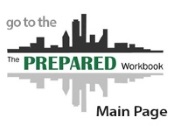PREPARED Workbook Resources
(PREPARED Municipal Workbook)
Brownfield Property InventoriesProperty Reuse Assessment
Environmental Due Diligence
CT Cleanup Programs
Environmental Land Use Restrictions
CT Lead/PCB/Asbestos Programs
Flood Plain Requirements
Liability Protection Programs
Funding Sources
Other Programs
Brownfield Property Inventories
The following links provide information on properties that have been identified as Brownfields or have been subject to corrective action under state or federal programs:Connecticut Brownfields Inventory lists properties identified as Brownfields by DEEP, DECD, and/or USEPA.
Connecticut List of Contaminated or Potentially Contaminated Sites lists Hazardous Waste Facilities as defined in Section 22a-134f of the Connecticut General Statutes (CGS).
Connecticut Superfund Priority List lists hazardous waste disposal sites have been deemed eligible for expenditure of State funds for remedial actions pursuant to Section 22a-133d of the Connecticut General Statutes (CGS).
EPA Cleanups in my Community - Connecticut (scroll down) lists properties in cleanup under Superfund, RCRA, Brownfields, and other federal cleanup programs.
Property Reuse Assessment
Brownfields Area-Wide Planning provides information on the USEPA's program that is intended to encourage the development and organization of actions to achieve the cleanup and sustainable reuse of Brownfield properties.
- The Climate Adaptation Checklist is intended to help Brownfield Area-Wide Planning (BF AWP) grant recipients meet the following grant term and condition for Climate Change Considerations.
The Decision Enhancer Tool was developed for the West Virginia Brownfields Assistance Center to facilitate the evaluation of potentially viable options for reuse of a Brownfields property.
The Municipal Primer provides basic information and guidance to municipal officials on a wide variety of topics related to environmental protection so that local decision-makers are informed about key environmental topics.
Environmental Due Diligence Process
All Appropriate Inquiry website (USEPA) provides information on the requirements to achieve liability protections under the federal Brownfields regulations.
Site Characterization Guidance Document describes the standard of care for conducting the environmental investigation of properties in Connecticut.ASTM E1527 - 13 Standard Practice for Environmental Site Assessments: Phase I Environmental Site Assessment Process (Document needs to be purchased).
ASTM E1903 - 11 Standard Practice for Environmental Site Assessments: Phase II Environmental Site Assessment Process (Document needs to be purchased).
CT Environmental Conditions Online provides online resources to evaluate sensitive receptors.
Connecticut Department of Administrative Services (CT DAS) Environmental Policy Act Manual outlines the requirements for an Environmental Impact Evaluation (EIE).
EnviroFacts is a USEPA website that provides access to several USEPA databases containing information about facilities that are required to report activity that may affect air, water, and land in the United States to a state or federal system.
Connecticut Cleanup Programs
Property Transfer Program (CGS Section 22a-134 through 134-e) requires the disclosure of environmental conditions when certain properties and/or businesses are transferred.
Voluntary Remediation Programs - CGS 22a-133x is available to any person to facilitate the remediation of contaminated property, and CGS 22a-133y addresses environmental assessments and remediation of properties located in areas which have a GB or GC ground water classification.
Remediation Standard Regulations (RCSA Sections 22a-133k-1 through 22a-133k-3) are the State's site cleanup requirements.
Licensed Environmental Professional Program (CGS Section 22a-133v-1 through 22a-133v-7) describes the licensure of environmental professionals in Connecticut.
The LEP Factsheet provides an overview of the LEP Program.
Licensed Environmental Professional (LEP) Verifications (CGS Section 22a-133v) webpage describes the circumstances where a LEP may verify that investigation and remediation is complete.
CT DEEP has an LEP Roster for your convenience.
CT DECD Professional Services Selection Process.
CT DEEP Brownfields Program
Targeted Brownfield Remedy Guidance Document outlines an expedited process for addressing properties that meet certain criteria.
CT DEEP Reporting Requirements for Significant Environmental Hazards (CGS Section 22a-6u)
Water Supply Well Receptor Survey Guidance provides information on when a well receptor survey is warranted and the process for conducting the survey.
Underground Storage Tanks website addresses the design, installation, operation, closure and corrective action for underground storage tanks.
Reasonable Confidence Protocols (RCPs) and Laboratory QA/QC Data Quality Assessment/Data Usability Evaluation Guidance Document provide guidance on laboratory quality assurance and quality control and data usability.
CT DEEP Stewardship Permit covers the performance of long-term stewardship activities.
Environmental Use Restrictions
Connecticut Environmental Use Restrictions (EURs) (RCSA Section 22a-133q-1) provides information on the use of environmental use restrictions.
Engineered Controls Guidance Document provides information on the variance from the requirements of the remediation standard regulations needed to utilize an engineered control and provides information on the financial assurance required to ensure the proper operation and maintenance of an engineered control.
Connecticut Lead/PCB/Asbestos Programs
The Department of Energy and Environmental Protection (DEEP) Renovation & Demolition website addresses asbestos, lead-based paint, PCB and other environmental, health, and safety requirements.
Lead - The following links provide information on the handling of lead-based paint related materials:
- Lead Poisoning Prevention and Control Regulations
- Lead-Based Paint Disposal Regulations
- Guidance for the Management and Disposal of Lead-Contaminated Materials Generated in the Lead Abatement, Renovation, and Demolition Industries
Asbestos - The following links provide information on the handling of asbestos-containing materials:
- DPH Asbestos Program
- Asbestos Statutes and Regulations
- National Emission Standards for Hazardous Air Pollutants (NESHAP)
PCBs - The following links provide information on the handling of PCB-containing materials:
- CT Department of Energy and Environmental Protection PCB information
- US Environmental Protection Agency PCBs in Building Materials
Asbestos and PCB Disposal Regulations
- Connecticut Solid Waste Management Regulations
- Connecticut Regulations for Solid Waste Permit Fee
- USEPA TSCA PCB Disposal Regulations
Flood Plain Requirements
Connecticut Flood Management and Natural Mitigation
Connecticut mill conversion exemption for flood management requirements (CGS Section 25-68d(e)).
Liability Protection Programs
Connecticut Liability Protection Programs
Abandoned Brownfield Cleanup Program (CGS Section 32-768) offers liability protection to developers not responsible for contamination on a property.
Brownfield Remediation & Revitalization Program (CGS Section 32-769) offers liability protection to a bona fide prospective purchaser, innocent land owner, or contiguous property owner.
Municipal Brownfield Liability Relief Program (CGS Section 22a-133ii) offers liability protection to a Municipality that takes title to a property.
Municipal Access Liability Relief (CGS Section 22a-133dd) allows a municipality or economic development agency or retained LEP to enter a property to conduct an investigation without liability under certain circumstances.
CT DEEP Third Party Liability Protection (CGS Section 22a-133ee)
CT DEEP CERCLIS Comfort Letter
CT DEEP Environmental Use Restrictions
CT DEEP Covenant Not to Sue
Federal Liability Protection Programs
See references provided in Chapter 7 and Appendix D of the PREPARED Workbook.
See references provided in Potential Liability under Federal and State Cleanup Statutes in Appendix E of the PREPARED Workbook.
Funding Sources
Connecticut Funding Sources
Connecticut Innovations contains information about financing, grants, and venture solutions.
Siting Clean Energy on Brownfields contains resources for clean energy production on brownfields.
Targeted Brownfield Development Loan Program covers costs associated with the investigation, assessment, remediation and development of a brownfield.
Urban and Industrial Sites Reinvestment Tax Credit program allows the state to provide up to $100 million in tax credits over a ten-year period to support projects that create significant jobs and capital investment in these underserved areas.
Brownfield Municipal Grant Program is a competitive grant for costs associated with the investigation, assessment, remediation and development of a brownfield.
Dry Cleaning Establishment Remediation Fund grants for clean-up releases of tetrachloroethylene, Stoddard solvent or other chemicals used for dry cleaning.
Federal Funding Sources
US Environmental Protection Agency Brownfields Grant Funding:
- Brownfields Assessment Grants
- Revolving Loan Fund Grants
- Brownfield Cleanup Grants
- Environmental Workforce Development and Job Training Grants
- Multi-Purpose Pilot Grants
- Training, Research, and Technical Assistance Grants
- Targeted Brownfields Assessments
See references provided in Community Issues – Funding Sources in Appendix E of the PREPARED Workbook.
See references provided in Managing Project Risk in Appendix E of the PREPARED Workbook.
Other Programs
CT DEEP Reporting Requirements for Spill Incidents (CGS Section 22a-450)
CT DEEP Water Quality Standards and Classifications and Water Quality Classification Maps (Regulations of Connecticut State Agencies Section 22a-426-1 to 22a-426-9)
CT DEEP RCRA Contained-In Policy
CT DEEP Connecticut Environmental Conditions Online (CTECO) provides information on wetlands, critical habitats, and natural diversity database areas.
CT DEEP Wetlands
CT DEEP Environmental Justice Program
Connecticut Office of the Permit Ombudsman is a resource for navigating permitting and interagency issues.
Department of Public Health (DPH) Site Assessment and Chemical Risk provides information on health concerns about hazardous waste sites in Connecticut.
Agency for Toxic Substance and Disease Registry (ASTDR) ToxFAQs provides information about contaminants found at hazardous waste sites.
Content Last Updated January 10, 2022



